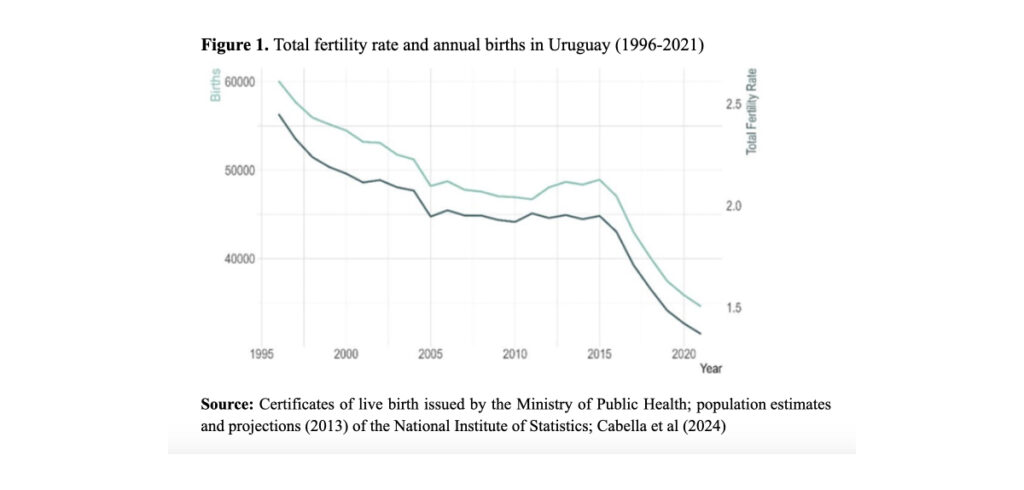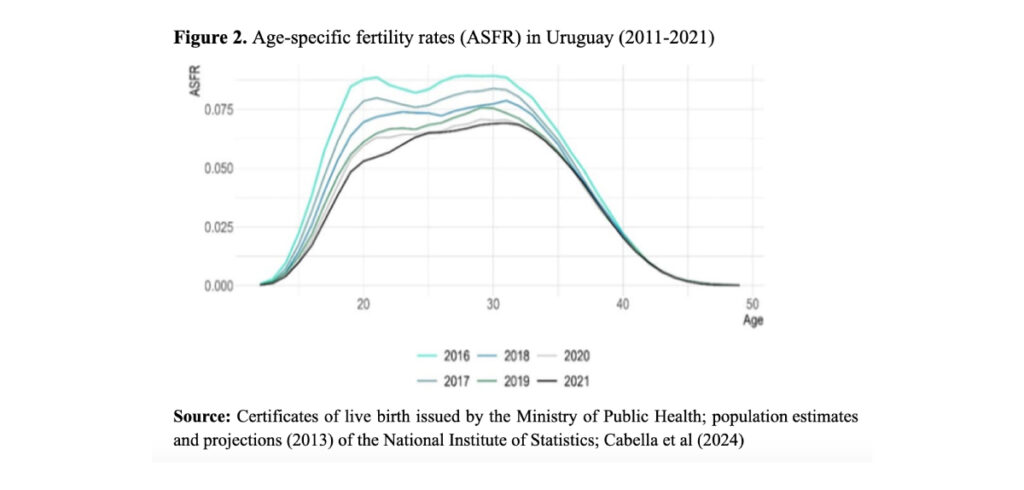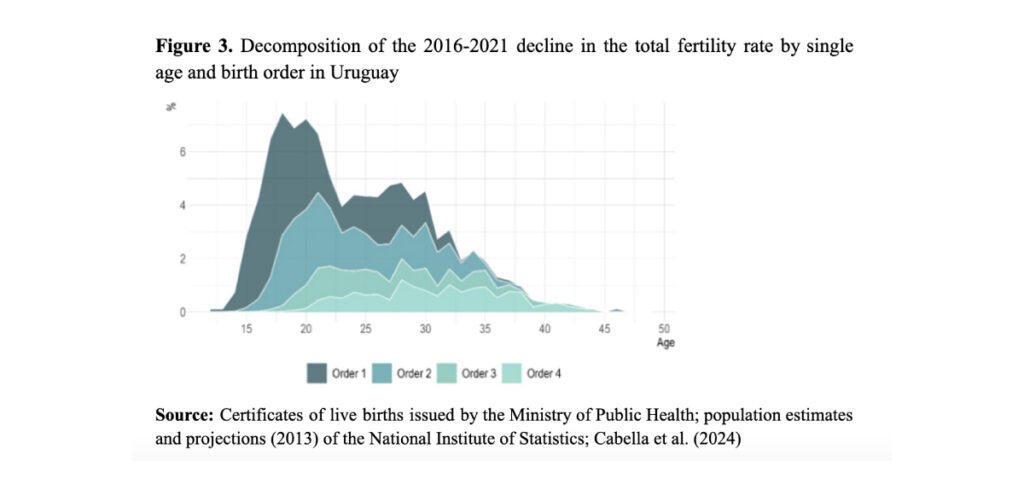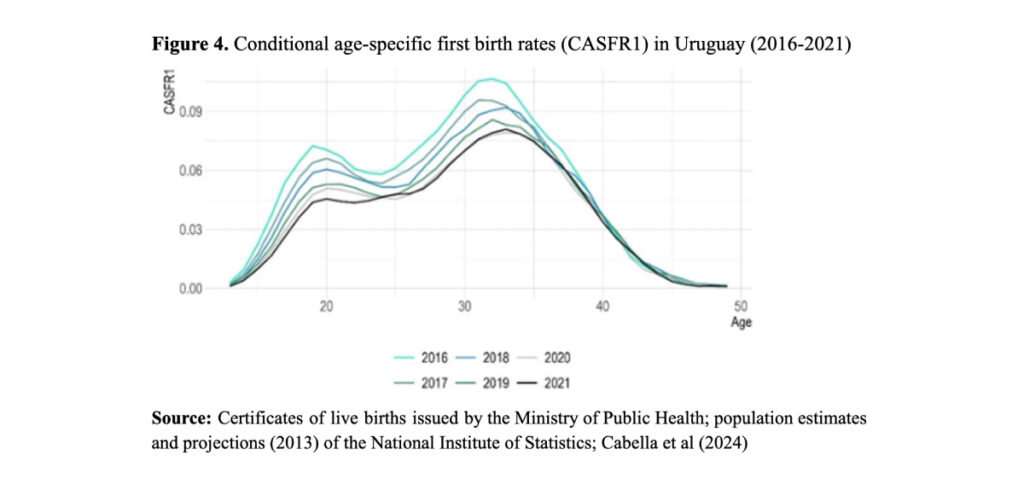Plummeting fertility in Uruguay, 2016-2021

Uruguay’s total fertility rate plummeted from nearly 2 children per woman in 2015 to 1.37 in 2021. As Wanda Cabella, Mariana Fernández Soto, Ignacio Pardo, Gabriela Pedetti note, this unprecedented decline was mainly fueled by decreasing adolescent and early fertility rates.
In the mid-20th century, Uruguay had a total fertility rate (TFR) of 3 children per woman, half the Latin American average, following a very early demographic transition. At the turn of this century, TFR approached replacement level in most Latin American countries, aligning Uruguayan fertility with regional trends, particularly, the coexistence of low total fertility and high adolescent fertility rates, typical of Latin American populations.
The three phases of the fertility decline
In more detail, the recent evolution of Uruguayan fertility can be broken down into three distinct phases:
1) a decline to below replacement-level fertility (1996–2005),
2) a period of relative stability (1996–2015), and
3) a particularly sharp decrease from low to lowest-low fertility levels (2016–2021) (Figure 1).

In 1996–2005, the main mechanism fueling decline was the increasing adoption of a “stopping behavior” after 2 children, with a sharp reduction of births of order 3 or higher (Nathan, Pardo and Cabella 2016). Conversely, in 2016-2021, a large decline is apparent in all age groups, but particularly among younger women, up to age 22 (Figure 2).

Decomposing change: the role of young and adolescent fertility
The decomposition of change is more revealing, especially if we express it as the contribution of each age and birth order to the reduction of the TFR (Figure 3). In the area corresponding to order 1, the reduction in first births before the age of 24 accounts for 30% of the total decline over the period. The decrease in second births among women under that same age was another important contributing factor, accounting for 15% of the total. Finally, more than a fifth of the decline is explained by the decrease in third and higher-order births among women aged 30 or above.

In short, a sharp decline in first births in adolescence and early youth, associated primarily with the postponement of the first birth, played a major role in the decline, but stopping was the most probable mechanism behind the reduction of higher order fertility rates among older women.
Mean age at first birth, which remained stable at around 24 years for a few decades and increased by barely a year between 1978 and 2011 (Nathan 2015), climbed by 1.5 years during the six years (2016-2021) of the big decline (from 24.9 to 26.4 years). Graphically, this change in the fertility regime can also be seen with conditional fertility rates: the traditional bimodal curve of the age at first birth is gradually transforming into a unimodal one (Nathan, Pardo, and Cabella 2016; Pardo and Cabella 2018). While this more flattened pattern still represents considerable heterogeneity in fertility timing, it contrasts drastically with the bi-modal shape of 2016 (Figure 4).

Conclusions: behavioral change and future trends
What explains this abrupt fertility decline? Considering that lower adolescent and early fertility played a leading role, it is reasonable to assume that most women deferred their first child during the period, probably exploiting the modern subdermal contraceptive implants, whose use has increased rapidly in recent times (Ceni et al. 2021). If this is true, some of the births that were avoided by adolescents and young women during the big decline will take place in the coming years, increasing rates in the 25-29 and older age groups. This might trigger a slight rebound in the TFR at some point, although it is difficult to predict its timing and extent.
The factors behind the decision not to have a(nother) child are not fully understood yet, but several contextual aspects may be considered. After a thirty-year period of extensive family change that resembled the Second Demographic Transition, Uruguay witnessed large-scale public debates on sexual and reproductive health rights, and the implementation of associated policies. For instance, abortion and same-sex marriage were legalized in 2012 and 2013, respectively. Some years later, official sex education programs were amended, and the National Strategy for the Prevention of Unintentional Adolescent Pregnancy was introduced.
With the spread of feminism in the Southern Cone, the big decline also overlapped with intense social change. Some of the main issues of the public debate during these years are relevant to a discussion on reproductive behavior. These include the difficulties of reconciling work and childcare, the potential conflict between family life and leisure, and the social normativity associated with motherhood.
It is also true, however, that no major social or economic shock has occurred in recent years in Uruguay, and that the true causes of the abrupt fertility decline of 2016–2021 remain poorly understood.
References
Cabella W., Fernández Soto M., Pardo I., Pedetti G. (2024) The big decline: lowest-low fertility in Uruguay (2016–2021). Demographic Research 50(16): 443–456. 10.4054/DemRes.2024.50.16
Ceni R., Parada C., Perazzo I., Sena E. (2021). Birth collapse and a large‐scale access intervention with subdermal contraceptive implants. Studies in Family Planning 523: 321–342. doi:10.1111/sifp.12171.
Nathan M. (2015). La creciente heterogeneidad en la edad al primer hijo en Uruguay: Un análisis de las cohortes 1951–1990. Notas de Población 100: 35–60. doi:10.18356/ecf4b5ea-es.
Nathan M., Pardo I., Cabella W. (2016). Diverging patterns of fertility decline in Uruguay. Demographic Research 34(20): 563–586. doi:10.4054/DemRes.2016. 34.20.
Pardo I., Cabella W. (2018). A bimodal pattern in age at first birth in southern cone countries? Population Review 57(2): 1–22. doi:10.1353/prv.2018.0004.